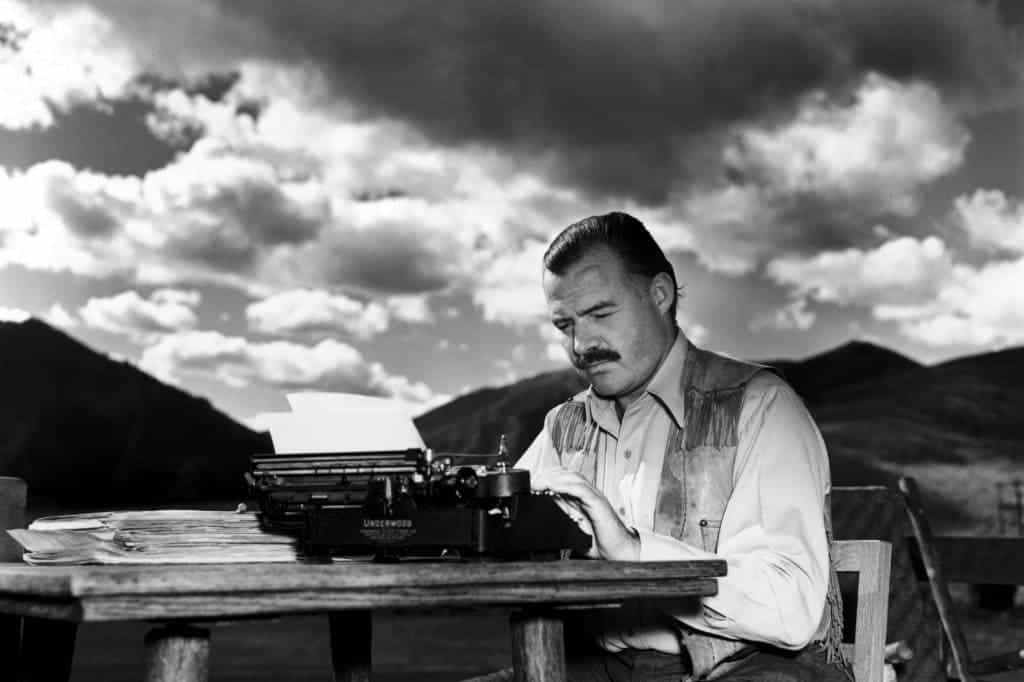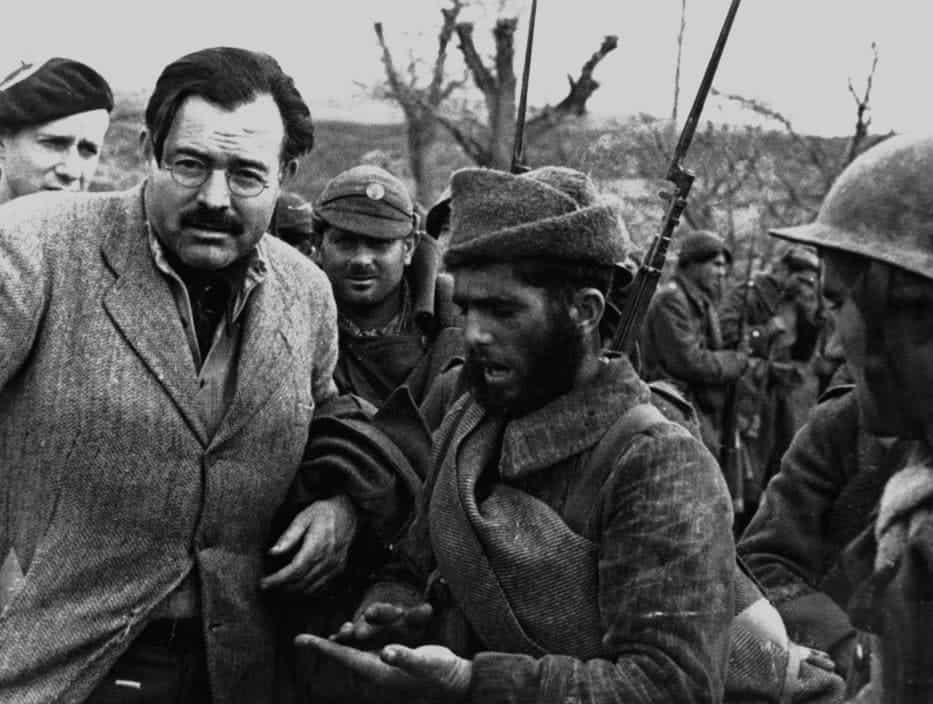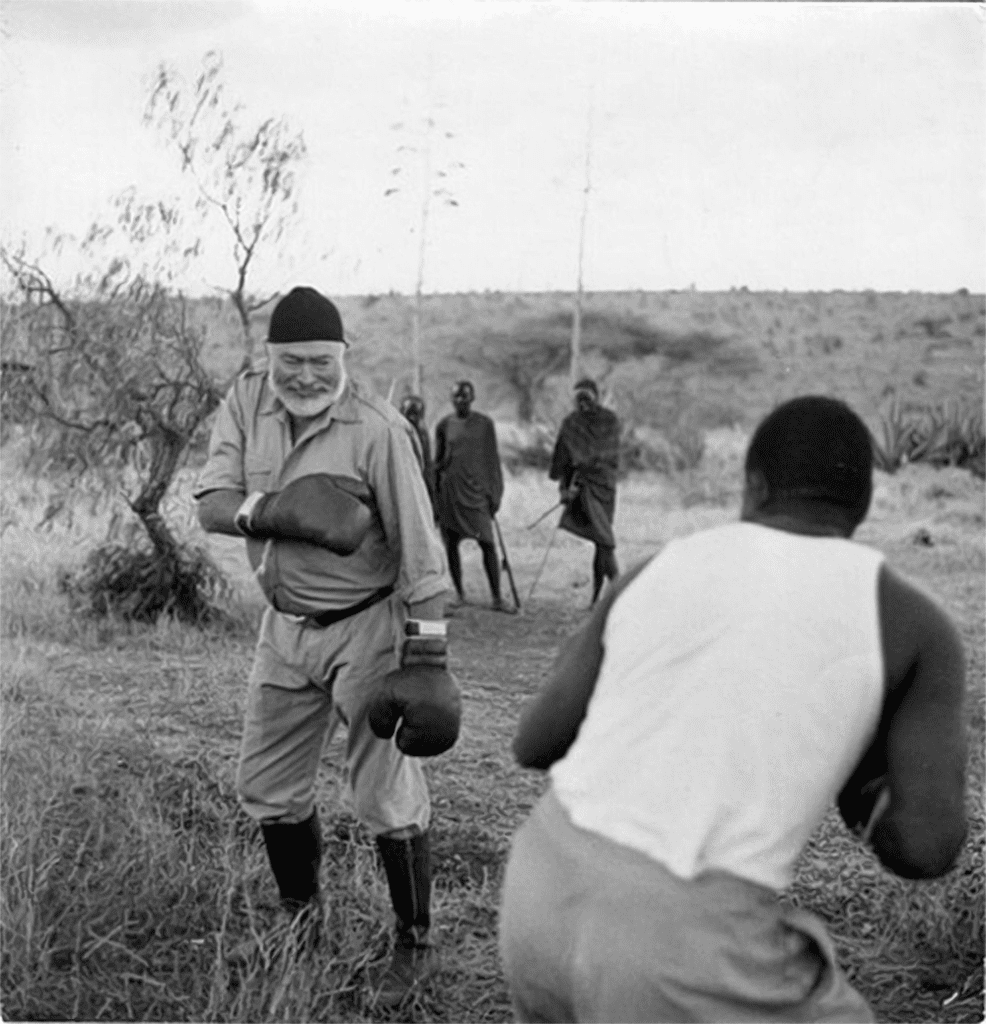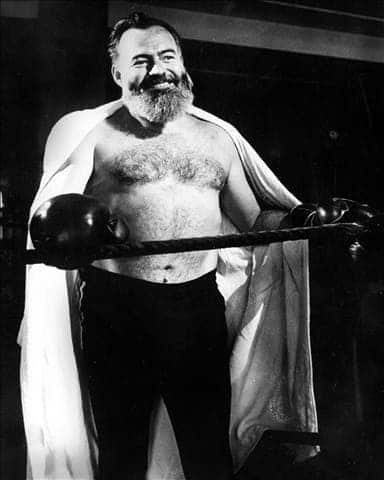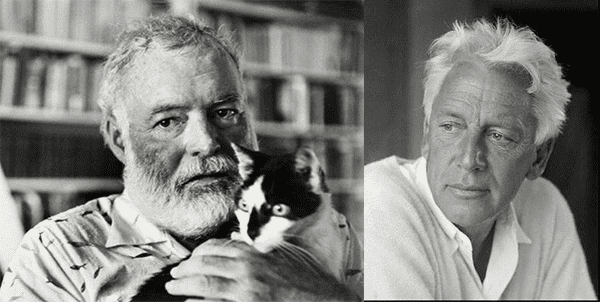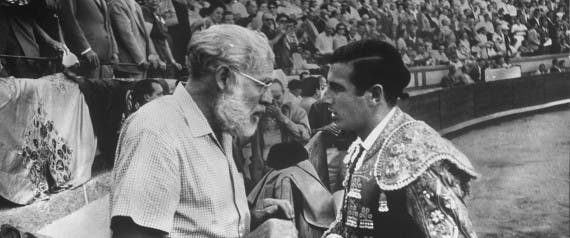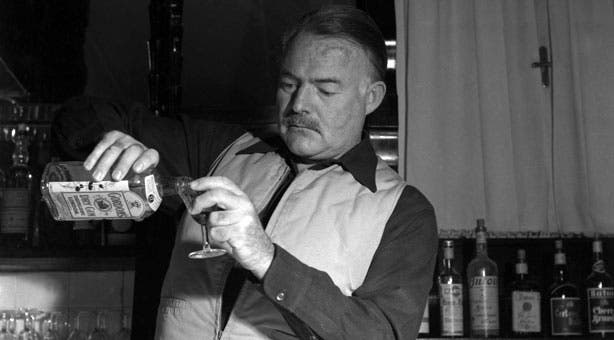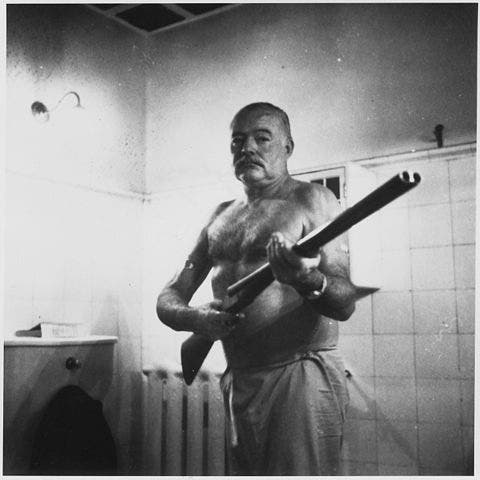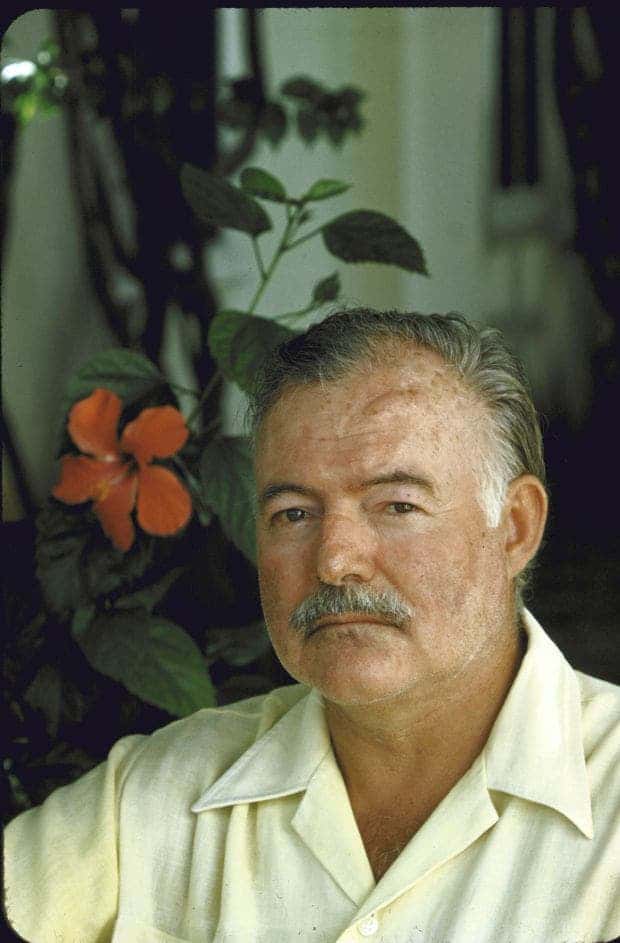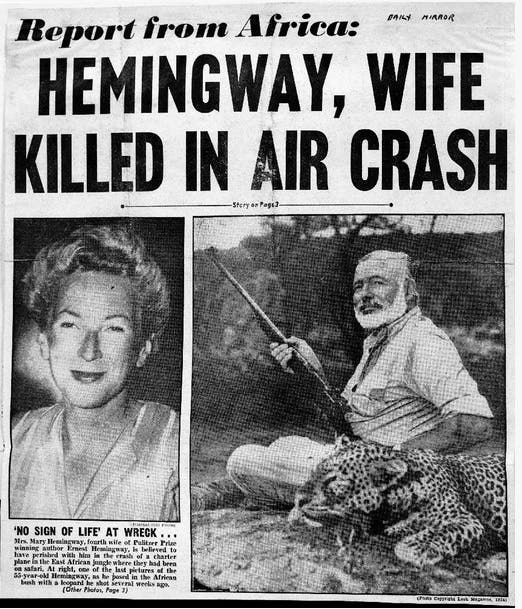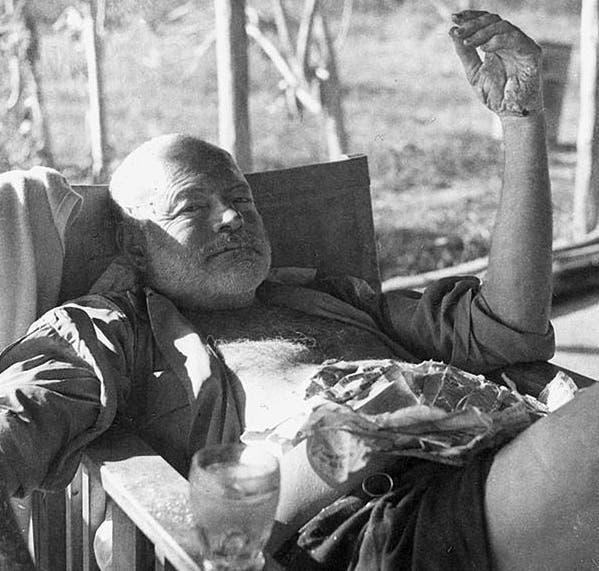Ernest Hemingway is famous for being one of the most appreciated American fiction writers. However, his personal life is no less interesting. A tough, hard-driving, hard-drinking, larger-than-life figure who hunts big game on the savannah, cheers toreadors, covers wars, and always, always writes.
Reading the countless biographies and reports of Hemingway’s life, it’s easy to lose track of the fact that Hemingway also suffered from some serious mental health conditions. He was a real badass for sure, but he could also be a real prick!
Hemingway is also a genuine survivor, too. He lived through anthrax, malaria, pneumonia, dysentery, skin cancer, hepatitis, anemia, diabetes, high blood pressure, two plane crashes, a ruptured kidney, a ruptured spleen, a ruptured liver, a crushed vertebra, and a fractured skull.
It seems like the only thing that could kill Hemingway was Hemingway himself. Alas, this was exactly what happened. He believed the FBI would ransack his things and follow him around. This and other borderline psychotic episodes prompted his wife to admit him to a mental hospital. There, he received electric shocks until he couldn’t remember his name anymore, let alone write. He killed himself shortly after his 36th electric shock. Ironically, the FBI admitted they were following Hemingway and ransacked his belongings.
“Every man’s life ends the same way. It is only the details of how he lived and how he died that distinguish one man from another.”
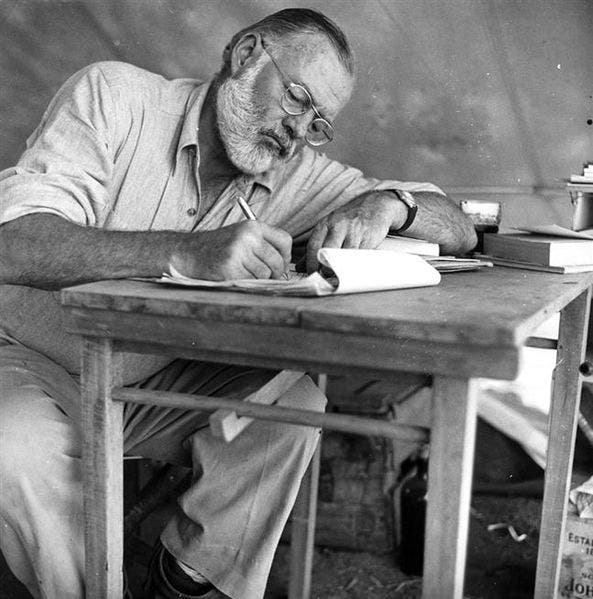
At times, it’s difficult to decipher where Hemingway’s life and his legend part. Luckily there is an overwhelming amount of information on his life. From his birth in Oak Park, Illinois, through the novels that were taken from his own experiences to his death at 62, Hemingway’s life was thoroughly documented. It’s easy to fall in the deep well that was Hemingway’s life and never come out, though.
“If you get too fixated on Hemingway, you lose the ability to understand him,” says Michael Reynolds, author of several books on Hemingway’s life.
Hemingway was born in 1899, and like any child born at the dawn of a new century, his childhood was marked by a period of rapid progress and change that swept the US. His father was a doctor while his mother was a musician. Together, Hemingway’s parents greatly influenced the writer and got him interested in sciences and objective reasoning, but also arts. “He really grew up with a rich environment of culture, religion, and the sciences,” says Redd Griffin, historian and board member of the Ernest Hemingway Foundation of Oak Park.
After graduating high school, Hemingway moved to Kansas City where he got a job as a cub reporter for the Star, covering the local beat that included fires, work strikes, and crime. This brief stint between 1917 and 1918 went to greatly influence him as a writer, as Hemingway himself later acknowledged. It was during this time that Hemingway formed his streamlined prose infused with “short declarative sentences.”
A born explorer, Hemingway enlisted in the army to fight in the war. Due to medical reasons, he wasn’t allowed to serve as a soldier, so instead, he volunteered as an ambulance driver for the Red Cross.
He was wounded in both legs by mortar and machine-gun fire. That didn’t stop him from getting his fellow soldiers to safety and out of the line of fire, which earned him the Italian Silver Medal of Military Valor, despite not even being Italian. Hemingway kept the piece of shrapnel, along with a small handful of other “charms” including a ring set with a bullet fragment, in a small leather change purse.
While hospitalized in Milan, Hemingway fell in love with a nurse. The experience, scholars say, inspired him to write the classic “A Farewell to Arms” (1929) – the story of a World War I ambulance driver who is injured in action and falls for his nurse. The ending is a lot more tragic, though.
Though he didn’t fight in any war, he did, however, work as a war correspondent in both the Spanish Civil War and World War II, having landed on Normandy for D day on the seventh wave, in an LCVP commanded by Lt. (jg) Robert Anderson.
In fact, during WII Hemingway equipped his fishing boat with direction-finding equipment, a machine-gun, and grenades to hunt for Nazi U-boats in the Atlantic. In his memoirs, Hemingway’s son wrote that they only saw one sub. It was far away and was way too fast for them to ever catch so nothing came of it.
They also practiced how they would throw the grenades at the subs by blowing up sea turtles. Hemingway never had any respect for animals, a widely known fact. Nevertheless, no American writer is more associated with writing about war in the early 20th century than Ernest Hemingway. He experienced it firsthand, wrote dispatches from innumerable frontlines, and used war as a backdrop for many of his most memorable works.

“Going back to Africa after all this time, there’s the excitement of a first adventure. I love Africa and I feel it’s another home, and any time a man can feel that not counting where he’s born, is where he’s meant to go.”
An accomplished outdoorsman, Hemingway loved to hunt and fish. He felt equally at home stalking lions in Africa or cruising the Gulf Stream in search of marlin and tuna. According to personal accounts and letters sent to friends, though, it was on safaris in Africa that Hemingway felt most alive.
He was such a good hunter that during his second safari the local game warden even left him temporarily in charge of the district he was quartered in. Hunting and fishing were an integral part of who Hemingway was, which is no wonder that the themes are often reflected in his masterful works of fiction, from his famous account of an African safari in “The Short Happy Life of Francis Macomber” to passages about duck hunting in “Across the River and Into the Trees”.
He also wrote a whole book about his hunting experiences called “Hemingway on Hunting”, which features selections from his best-loved novels and stories, along with journalistic pieces from such magazines as Esquire and Vogue.
“My writing is nothing, my boxing is everything.”
His other life passion was boxing. He practiced the sport since childhood and was quite good at it, at one point being considered a successful amateur boxer. He even had a boxing ring built in the backyard of his Key West home, right next to the pool, so that he could spar with guests.
When he wasn’t boxing himself, he would sometimes act as a referee. One time, he was the referee in a match where one of the fellows was receiving a serious beating to the point of abuse, but the fighter would never back down and rise each time he would get knocked down.
The fighter’s manager “Shine” Forbes at one point had enough and threw the towel on the floor to signal the concede. Not your typical ref, Hemingway took the towel and threw it out of the ring. This went back and forth for a couple of times until Shine, furious like a bull, stepped into the ring and punched the ref. It was only later that Shine learned the man he had punched was none other than Ernest Hemingway.
Embarrassed he visited Hemingway’s home to apologize. Hemingway was not bothered at all by the incident and the two eventually became quite close friends.
In another famous instance, Hemingway demonstrated not only his superior boxing skills but also his fishing abilities. While on a fishing tournament in Bimini, Hemingway enraged the locals after he fished the waters better than some of the previous champions who had been fishing their entire lives. To make up for it, Hemingway offered the locals to give back their lost tournament money. But not for free – challengers had to go in the ring with big Papa for three rounds and win. One contender was a man who the locals said could “carry a piano on his head.” Unimpressed, the 35-year-old Hemingway beat him in under a minute and a half. The other three challengers suffered a similar fate.
“Develop a built-in bullshit detector.”
A megalomaniac, Hemingway did not take lightly those who tarnished his macho reputation. One notable episode involves an altercation between Hemingway and fellow writer Max Eastman in their publisher’s office one day in 1937. Hemingway was furious when he found a line in Eastman’s new essay which read “Come out from behind that false hair on your chest, Ernest. We all know you.” He confronted Eastman and in his uncanny style challenged the writer to take his shirt off and see who had more chest hair. Needless to say, Hemingway had the most hair. Triumphant, Hemingway proceeded to hit Eastman in the face with his own book. According to a 1937 NY Times article, Eastman allegedly then threw Hemingway over a desk and stood him on his head in a corner. Hemingway denied this happened and offered a new challenge:
“If Mr. Eastman takes his prowess seriously — if he has not, as it seems, gone in for fiction — then let him waive all medical rights and legal claims to damages, and I’ll put up $1,000 for any charity he favors or for himself. Then we’ll go into a room and he can read his book to me–the part of his book about me. Well, the best man unlocks the door.”
There was no reply from Eastman.

“Bullfighting is Not a Sport – It is a Tragedy”
Hemingway’s 1926 novel “The Sun Also Rises” turned Pamplona’s annual fiesta of San Fermin from a local event into an internationally recognized one that attracts around a million visitors each year. The novel describes a trip made by a group of Bohemians from Paris to Pamplona in the 1920s and is inspired by characters he met in post-war France and his initial visit to the capital of Navarra with his first wife Hadley in 1923.
In an NYTimes article from 1932, a journalist writes “Mr. Hemingway knows bull-fighting at least, as well as the specialized sportswriter in our own country, knows baseball, football, racing or fighting. He knows it so well that on occasion only the introduction of an extremely singular old lady as the author’s interlocutor, a few digressions on death, modern literature, and sex life, joined with Mr. Hemingway’s extremely masculine style of writing, save the reader from drowning in a flood of technicalities.”
In a piece for the Toronto Star in 1923, Hemingway wrote bullfighting “symbolizes the struggle between man and beasts. The three acts of the drama are the entry, the planting of the banderilleros, and the death of the bull. A Canadian at ringside.”
Letter to Ezra Pound, July 19, 1924:
Dear Ezra—Here, at 900 meters above the Nivel del Mare on the Spanish side of the Pyrenees is a good place to observe the ruin of my finances and literary career. Shit. I appeared in the bull ring on 5 different mornings—was cogida 3 times—accomplished 4 veronicas in good form and one natural with the muleta, the last morning, received contusions and abrasions in the pecho and other places, was drunk twice, saw Bill drunk twice…We haven’t enough pesetas now to pay our hotel Bill and dont know how we’ll get away from here.
…Having been bitched financially and in a literary way by my friends I take great and unintellectual pleasure in the immediate triumphs of the bull ring with their reward in ovations, alcoholism, being pointed out on the street, general respect and the other things Literary Guys have to wait until they are 89 years old to get.
The Plaza is the only remaining place where valor and art can combine for success. In all other arts the more meazly and shitty the guy, I.E. Joyce, the greater the success in his art…
Then when a guy has a few decent human instincts like yourself what do they do to him? I wish to hell I was 16 and had art and valor.
…I am going to have to quit writing because we haven’t any money. The Transatlantic killed my chances of having a book published this fall and by next Spring some son of a bitch will have copied everything I’ve written and they will simply call me another of his imitators.
Now we haven’t got any money anymore I am going to have to quit writing and I never will have a book published. I feel cheerful as hell. These god damn bastards.
See you about the 27th of the month.
Love to Dorothy—
Hem.
“I drink to make other people more interesting.”
It’s no secret Hemingway enjoyed a tipple or two, to say the least. He liked his Martini dry, his Mojitos sweet, and was rumored to be drinking a quart of whiskey a day later in his life. Just to get an idea, here’s a great find tweeted by Letters Of Note featuring Hemingway’s postscript to a letter to Ivan Kashkin, a Russian translator, and critic, in 1935.
Hemingway explains his love of alcohol in a P.P.S. pic.twitter.com/FDQViJskE7
— Letters of Note (@LettersOfNote) July 2, 2013
In fact, Hemingway was such a notorious enthusiast of alcohol that there’s even a myth that attributes the invention of the famous cocktail “Bloody Mary” to him. The legend has it that the drink was first served to Hemingway in Paris. As the story goes, his doctors had forbidden him from having alcohol, and his wife, Mary, was holding him to it. A bartender at the Ritz mixed him the vodka-and-tomato juice drink, full of booze that could not be detected thanks to the other strong ingredients. Having got the better of his “bloody wife,” the cocktail was christened after her. A number of sources have debunked this myth.
It’s true, however, that he indeed invented a drink during his stints in Havana: the Papa Doble. Journalists and guests recorded the drink recipe for posterity, but there are small disagreements about the exact mixture. Here’s one version you might want to try at home:
- 2oz white rum
- ½ lime
- 2 tbsp grapefruit juice
- ½ tbsp maraschino cherry
- Shake, and pour into glass FULL of shaved or crushed ice. It is a settled fact that Hemingway liked his drinks with copious amounts of ice.
“Never sit at a table when you can stand at the bar.”
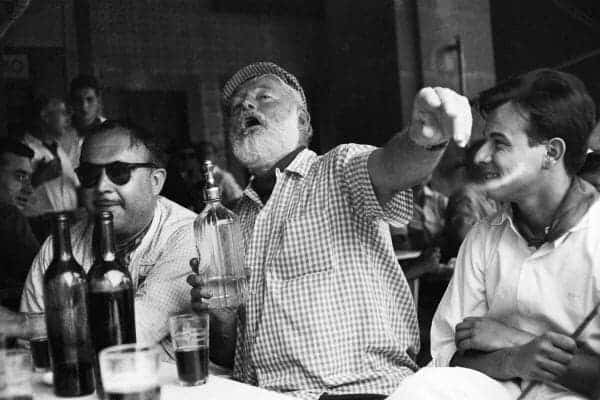
While he loved alcohol, Hemingway always refrained from drinking when working. When asked in an interview if rumors of him taking a pitcher of martinis to work every morning were true, he answered, “Jeezus Christ! Have you ever heard of anyone who drank while he worked? You’re thinking of Faulkner. He does sometimes – and I can tell right in the middle of a page when he’s had his first one. Besides, who in hell would mix more than one martini at a time?”
“When you stop doing things for fun you might as well be dead.”
“Death is like an old whore in a bar–I’ll buy her a drink but I won’t go upstairs with her.”
Despite his numerous adventures and close calls, death always seemed to escape Hemingway. Besides the shrapnel from WWI, he also bore a bullet wound after he accidentally shot himself while trying to finish off a still thrashing shark he had dragged aboard while shark hunting.
Shooting yourself in the leg is always embarrassing, but Hemingway gets off since it happened while he went shark fishing. Later in life, he survived anthrax, malaria, pneumonia, dysentery, skin cancer, hepatitis, anemia, diabetes, high blood pressure, and several major injuries. However, the greatest trick he played against death was during his second safari when he survived not, but two place crashes!
In the winter of 1953-1954 Hemingway set of for Africa again. A bit older and changed – drinking far too much. Now traveling with his fourth and last wife, Mary, to enjoy another safari.
He also wanted to visit his son, who was living in Tanganyika. The visit was in the middle of Kenya’s Mau-Mau rebellion ignited by President Jomo Kenyatta against the British colonialists. The rebellion was very violent and Hemingway almost lost his life on this journey, but it was not as a victim of the Mau-Mau.
Over the Congo, his plane struck an abandoned utility pole and “crash-landed in heavy brush”. Hemingway’s injuries included a head wound while Mary broke two ribs. A few days later, he and his wife boarded a so-called rescue plane. In a stroke of bad luck, the plane had to perform an emergency dive to avoid a bird strike and the plane ground-looped, eventually crashing.
The plane was all up in flames, but Hemingway and Mary managed to escape alive, but not unscathed. They eventually arrived in Entebbe to find reporters covering the story of Hemingway’s death.
Here’s a complete list filled in by Hemingway himself in a letter to Kit Figgis, who, with her husband, Larry, assisted the Hemingways in the aftermath of the accidents and contributed to an article about their safari that was published in Look magazine.
“Dear Kit:I must have been pretty punchy when I wrote you the enclosed. Sent it as a curiosity you can always sell it for the children. I’ll get you the name of a dealer. What I sorted out to, according to…doctor, very practical type, was: major concussion, rupture one kidney, damage liver, collapse of intestines, Paralysis sphincter, 3/4 lost sight in one eye (left) (never any good anyway), Burns head, Brush fire = burns on lips (light), left hand severe, right forearm ditto, abdomen (light), legs (Light). Am beating all raps OK. But you can’t beat lives many…Had cable from Bill Lowe that everything sold and 1st installment in Look April 20th on the newsstands…Kit this trip has been a little rugged. All the effects were delayed. Good thing we did the piece when we did although we could have done it the worst days ever saw…If I haven’t paid Major…(there are about 2 blank weeks) give him my permanent address 90 Guaranty Trust Co of N.Y. 4 Place de la Concorde, Paris, France and tell him to bill me there…Please kiss my godson…Love Papa. (March 17, 1954)”
Once he reached his sixties, Hemingway found that he could no longer write. In the spring of 1961, he was asked to contribute something brief to a presentation volume for John F. Kennedy’s inauguration. Just a single sentence. He couldn’t do it. “It just won’t come anymore,” he told a close friend, and he was weeping as he said it.
At the end of his life, Hemingway was fraught with paranoid delusions. He thought his friends were trying to murder him. He thought two men working late in a bank were “Feds” auditing his bank accounts.
A paper published in 2006, examined his life through a review and discussion of biographies, psychiatric literature, personal correspondence, photographs, and medical records. The psychiatrists conclude ” evidence [..] support[s] the diagnoses of bipolar disorder, alcohol dependence, traumatic brain injury, and probably borderline and narcissistic personality traits.
Late in life, Hemingway also developed symptoms of psychosis likely related to his underlying affective illness and superimposed alcoholism and traumatic brain injury. Hemingway utilized a variety of defense mechanisms, including self-medication with alcohol, a lifestyle of aggressive, risk-taking sportsmanship, and writing, in order to cope with the suffering caused by the complex comorbidity of his interrelated psychiatric disorders.”
He was eventually admitted to a mental health hospital. His last days were miserable and painful being subjected to electric shock therapy, as was the practice of the time.
Beginning in 1960, “they gave him 36 shock treatments at the Mayo Clinic in Rochester, Minnesota, and shock treatments back then were very severe,” Nagel says. “They caused serious memory loss in Hemingway. If there’s anything a writer can’t stand, it’s the loss of memory. After some of those shock treatments, he didn’t even know his name. Then he would be sent back home to recover, given that drug for high blood pressure, and it was only a matter of weeks before he was depressed again.”
Hemingway committed suicide on July 2, 1961, a day after his 36th shock treatment. He had earlier convinced doctors that he could return home. Oddly enough, suicide runs in the Hemingway family. His father shot himself at the age of 57, using a Civil War pistol. His brother and sister and a granddaughter killed themselves, too.
The New York Times described the family tree as “blood-soaked as any from Greek tragedy,” and the term ”Hemingway curse” has become shorthand for the cycle of mental illness, addiction and suicide can afflict multiple generations
Ernest Hemingway: author of 27 astounding books and 50+ short stories, winner of both the Pulitzer and Nobel Prizes, Bronze Star recipient, world class sports fisherman, big game hunter, boxer, bullfighting aficionado, war correspondent. There’s a dark side, of course: he wasn’t much of a father, he drank too much, and he wasn’t very gentlemanly most of the time. But by golly, he sure had one heck of a life. Say what you will about the man, but I don’t think anyone can say he wasn’t an interesting figure. With good and bad, Hemingway lived the life he wished. If anything: remember always to have fun. I’ll drink to that.
